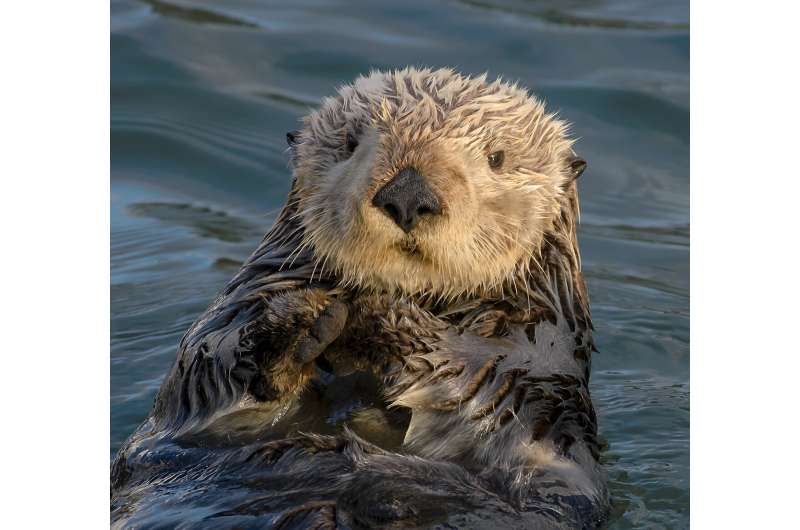January 20, 2024 report
This article has been reviewed according to Science X's editorial process and policies. Editors have highlighted the following attributes while ensuring the content's credibility:
fact-checked
trusted source
proofread
Saturday Citations: The cutest conservationists; a weird stellar object; vitamins good for your brain

There are fields of scientific research that involve neither vast cosmic phenomena nor extremely cute animals, but those are topics of high salience in Saturday Citations, and this week is no exception. And we'll probably play the odds and say next week won't be either.
Thing weird
Astronomers using the MeerKAT Radio Telescope identified a wack object orbiting a pulsar right here in the Milky Way that they describe as lighter than the lightest black hole and heavier than the heaviest neutron star, residing squarely in the black hole mass gap.
It could be the first discovery of a black hole/pulsar binary, which would enable previously impossible tests of general relativity; on the other hand, if it's a neutron star, astronomers could learn more about high-density nuclear physics, according to Professor Ben Stappers from the University of Manchester, a U.K. team lead.
Conservationists cute
When they're not busy swimming on their backs in pairs while holding paws, sea otters also confer benefits to healthy oceanic ecosystems. Researchers at the Monterey Bay Aquarium report a link between sea otters and the health of kelp forests.
Specifically, the growth of sea otter populations improved the resilience of kelp forests. Kelp forests benefit ocean ecology, serving as fish nurseries and reducing coastal erosion. But kelp forests off the coast of California are in widespread decline, dropping by more than 95%; remaining kelp grows in isolated patches.
These declines, driven by ocean warming, were abrupt, occurring between 2014 and 2021, and ecologists say they will be difficult to reverse. However, regions with high kelp forest density are correlated with high sea otter populations.
"In fact, we found sea otter population density as the strongest predictor of change in kelp canopy coverage across this hundred-year span," says lead author Teri Nicholson, senior research biologist with the Monterey Bay Aquarium Sea Otter Program. The researchers used historical surveys of kelp forests dating back a century and more recent aerial surveys. They suggest that reintroducing otters to coastal California could improve the prospects for kelp forests.
Cognition enhanced
Everyone knows that vitamins are a waste of money that you eventually flush down the toilet. But what this study presupposes is that maybe they aren't. Just take your Centrum Silver, say researchers at Mass General Brigham, who report positive effects on cognition from taking daily multivitamins.
Within a large study called COSMOS, in which a subset of 573 participants were administered cognitive tests, two previous studies tested multivitamin supplementation using telephone- and online-based cognitive assessments. The team reports a modest benefit for global cognition over two years, including a statistically significant benefit for change in episodic memory but no benefit for executive function and attention.
Emphasizing the relevance of their findings to the growing population of aging adults, Olivia Okereke, MD SM, senior author of the paper, says, "These findings will garner attention among many older adults who are, understandably, very interested in ways to preserve brain health, as they provide evidence for the role of a daily multivitamin in supporting better cognitive aging."
Sugar desirable
Researchers at the Monell Chemical Senses Center report a new gut-brain connection that drives cravings for sugar and fat. Nutritionists have wondered why cravings for these nutrients are so powerful, and theories include leveraging the brain's pleasure center and its associated neurochemistry.
But the answer turns out to be the gut-brain axis. The vagus nerve is a long, unsightly cranial nerve associated with parasympathetic control of the heart, lungs, and digestive tract. Among its functions, it sends sensory information about the nutritional density of food from the gut to the brain.
The researchers stimulated the gut vagal nerves of modified mice with light, inducing the mice to seek food stimuli—specifically, the food that engages specific circuits. They found separate fat and sugar craving pathways and reported that combining these pathways—i.e., by eating a Toblerone—amplifies the desire to eat more food.
"It's like a one-two punch to the brain's reward system… Even if the total calories consumed in sugar and fats stays the same, combining fats and sugars leads to significantly more dopamine release and, ultimately, overeating in the mice," says Guillaume de Lartigue, Ph.D., lead author of the study.
© 2024 Science X Network





















